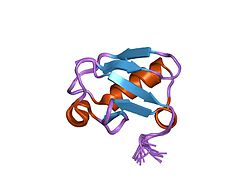| ASPSCR1 | |||||||||||||||||||||||||||||||||||||||||||||||||||
|---|---|---|---|---|---|---|---|---|---|---|---|---|---|---|---|---|---|---|---|---|---|---|---|---|---|---|---|---|---|---|---|---|---|---|---|---|---|---|---|---|---|---|---|---|---|---|---|---|---|---|---|
 | |||||||||||||||||||||||||||||||||||||||||||||||||||
| |||||||||||||||||||||||||||||||||||||||||||||||||||
| Identifiers | |||||||||||||||||||||||||||||||||||||||||||||||||||
| Aliases | ASPSCR1 , ASPCR1, ASPL, ASPS, RCC17, TUG, UBXD9, UBXN9, alveolar soft part sarcoma chromosome region, candidate 1, UBX domain containing tether for SLC2A4, ASPSCR1 tether for SLC2A4, UBX domain containing | ||||||||||||||||||||||||||||||||||||||||||||||||||
| External IDs | OMIM: 606236; MGI: 1916188; HomoloGene: 41550; GeneCards: ASPSCR1; OMA:ASPSCR1 - orthologs | ||||||||||||||||||||||||||||||||||||||||||||||||||
| |||||||||||||||||||||||||||||||||||||||||||||||||||
| |||||||||||||||||||||||||||||||||||||||||||||||||||
| |||||||||||||||||||||||||||||||||||||||||||||||||||
| |||||||||||||||||||||||||||||||||||||||||||||||||||
| |||||||||||||||||||||||||||||||||||||||||||||||||||
| Wikidata | |||||||||||||||||||||||||||||||||||||||||||||||||||
| |||||||||||||||||||||||||||||||||||||||||||||||||||
Tether containing UBX domain for GLUT4 (TUG) is a protein that in humans is encoded by the ASPSCR1 gene. [5] [6] [7]
This gene is a candidate gene for alveolar soft part sarcoma (ASPS). It has been found that ASPSCR1 can undergo oncogenic rearrangement with transcription factor TFE3 gene, creating an aberrant gene that is a stronger transcriptional activator than TFE3 alone. [8] This fusion oncogene encodes for a chimeric transcription factor, which is responsible for the production of multiple molecules that contribute to ASPS and also to renal cell carcinomas. [9] Several alternatively spliced transcript variants of this gene have been described, but their full length nature has not been determined. [7]




